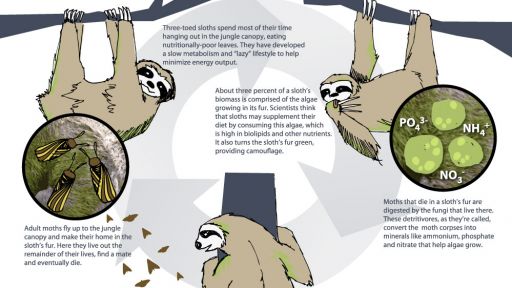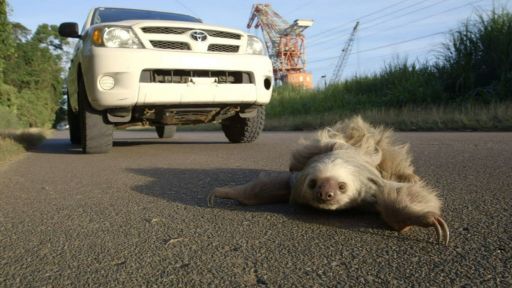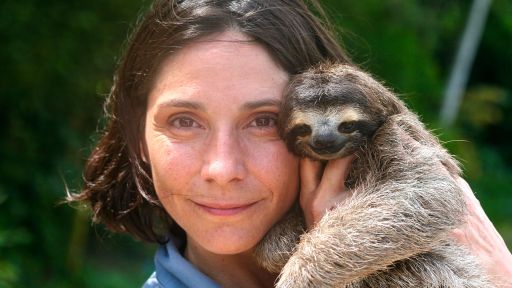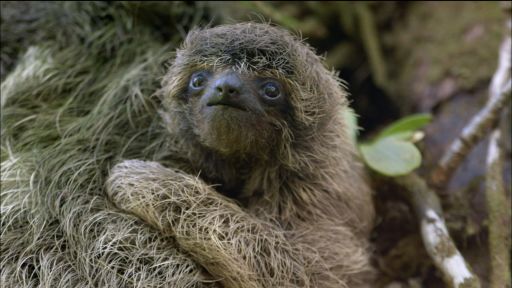In 2000, in the jungles of Panama, journalist Ana Salceda had a chance encounter with a tiny orphaned sloth, which she named Velcro. For nearly two years, the pair was inseparable until Salceda reintroduced Velcro back to the wild. A Sloth Named Velcro tells the story of Salceda’s relationship with Velcro and the extraordinary people committed to protecting sloths as development displaces these gentle creatures from their homes in the wild.
Salceda spoke with THIRTEEN.org  about this life-changing experience.
about this life-changing experience.
Q: What was the most challenging thing about raising Velcro, and the most rewarding?
A: Infant sloths are fragile and require very specific environmental conditions to thrive, many of which were incompatible with my lifestyle at the time. So I left my apartment in the city and moved to a former military base close to a jungle filled with trees Velcro needed for nourishment. But the most profound adjustment was carrying Velcro at all times so she could maintain a warm body temperature. She was literally attached to me for several months. That’s how she got her name.
Regarding the rewarding aspects of the experience, there were so many! I had to make quite a few sacrifices while caring for Velcro, but they were all worth it. Velcro taught me to appreciate silence, to see nature from the inside out, to be more patient and efficient – and she gave me so much tenderness. She was one of the best things that ever happened to me.
Q: What were you most surprised to discover about sloth behavior during your time with Velcro?
A: One of the most surprising things was how unsloth-like sloths can be. There were times when Velcro was up all night and I was convinced I was raising a hyperactive sloth! But scientists have discovered that sloths don’t sleep much more than humans do and can be quite social. In A Sloth Named Velcro, we meet a male sloth who is mellow during the daytime but quite the Casanova at night.
Q: How did you know when it was time to return Velcro to the wild?
A: I knew it was time to return Velcro to the wild when she was one year old and started to show signs of independence. For example, after she overcame her fear of heights, she started moving around the house through the pipes and structures attached to the façade. A couple of months later, she started to harvest the leaves she needed on the trees surrounding our home – something I had previously done for her. Later on, she would spend more time outdoors by herself and longer periods of time would pass before she returned home. I distinctly remember working at home one day and hearing her call outside. When I opened the door, she looked more like a wild animal than ever before: her coat looked a little green and she was carrying uninvited guests in her fur. That day, I knew she was ready for life in the wild.
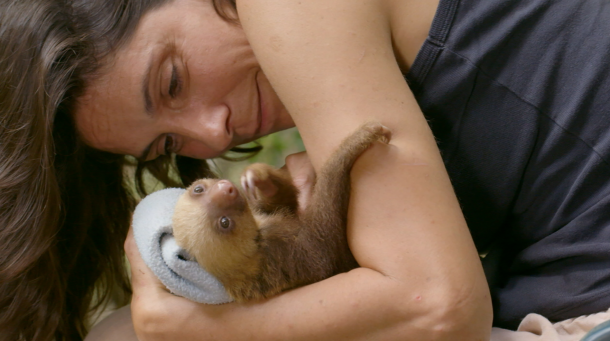
Salceda holds an orphaned two-toed sloth at the Jaguar Rescue Center in Costa Rica.
Q: How did you choose Velcro’s new home in the wild?
A: I had been looking for a place to release her – an area filled with trees and free of harpy eagles, ocelots, and the other predators she hadn’t yet faced. At the time, I was working for the Panama Canal, which allowed me to meet people living in the canal watershed. I became friends with Efraín Gutiérrez, a community leader living in a little village located where the Coclé del Norte River meets the Caribbean sea. He told me about a nearby patch of forest connected to a pristine mountain. It was the perfect spot for a soft release, and Efraín pledged to keep an eye on Velcro during the first months until she settled and found her own home.
Q:What was it like to work with NATURE?
A: Nature has a reputation for excellence. It’s a series where craftsmanship and quality go hand in hand – that’s one of the many reasons wildlife filmmakers are so eager to work with the Nature team. From our very first meeting, I knew Executive Producer Fred Kaufman and his team understood how important Velcro’s story was to me. The ideas they brought to the table throughout the entire production process were incredibly helpful and insightful. It truly felt like working with friends.
Q: What do you hope viewers will take away from this film?
A: I hope viewers see beyond sloths’ cute Mona Lisa smiles, and realize how fascinating, complex, and vulnerable they are. I hope they’re inspired by people like Tinka Plese, who is featured in the film and whose Aiunau Foundation rehabilitates displaced sloths and returns them to the wild. And I hope my relationship with Velcro shows people how nourishing the human-animal connection can be, how it brings us closer to nature, and to ourselves.

